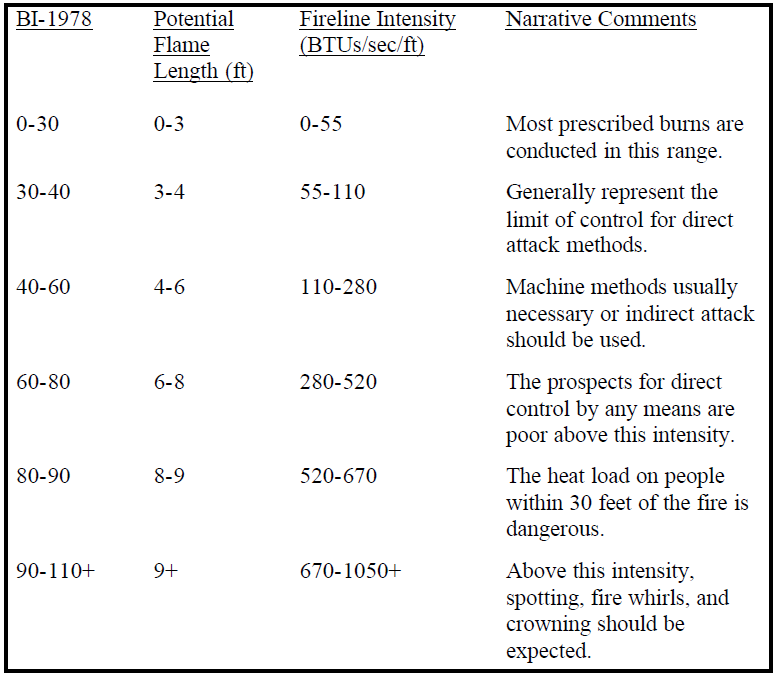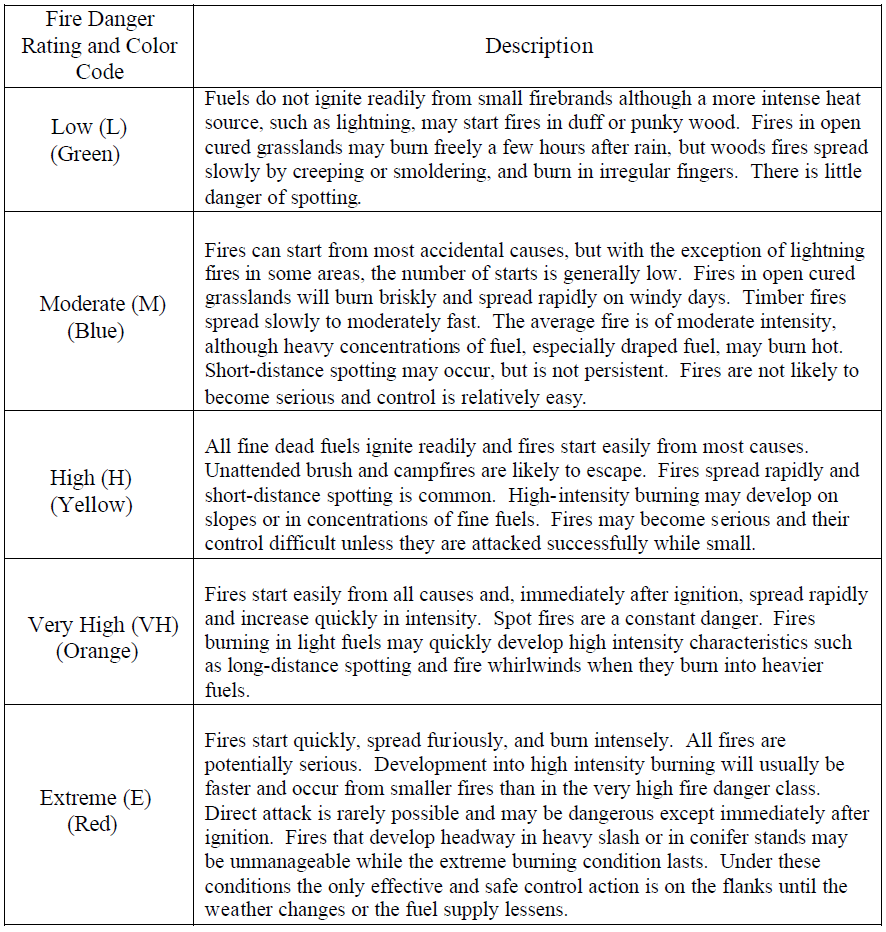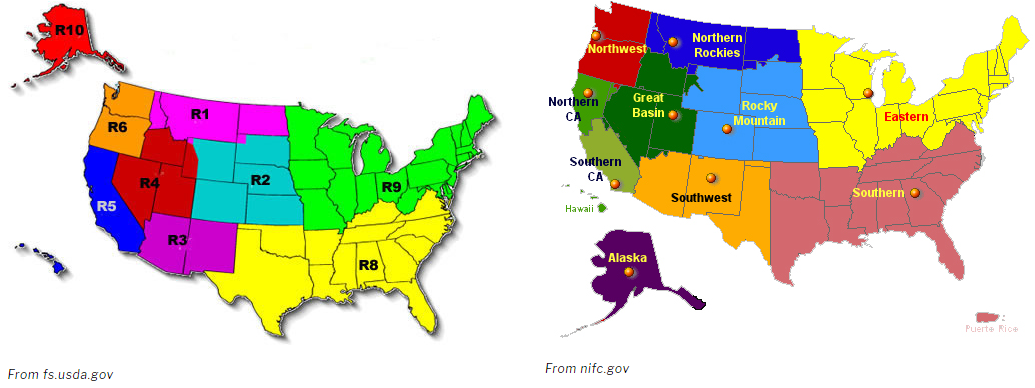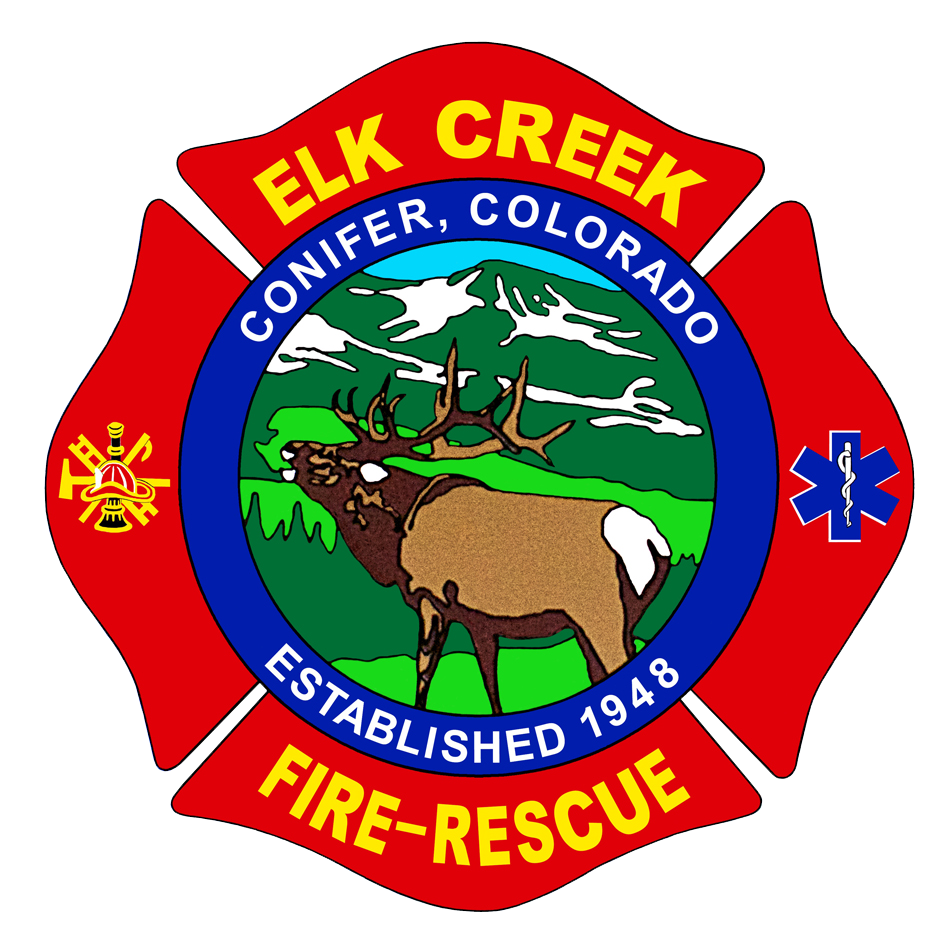Morning Wildfire Briefing
The following is the exact briefing all Elk Creek/Inter-Canyon Fire resources receive every morning during the wildland fire season.

Weather Briefing Definitions
- Haines Index
-
Haines Index- It is used to indicate the potential for wildfire growth by measuring the stability and dryness of the air over a fire. It is calculated by combining the stability and moisture content of the lower atmosphere into a number that correlates well with large fire growth. The stability term is determined by the temperature difference between two atmospheric layers; the moisture term is determined by the temperature and dew point difference. This index has been shown to be correlated with large fire growth on initiating and existing fires where surface winds do not dominate fire behavior.
The Haines Index can range between 2 and 6. The drier and more unstable the lower atmosphere is, the higher the index.
- 2 : Very Low Potential -- (Moist Stable Lower Atmosphere)
- 3 : Very Low Potential
- 4 : Low Potential
- 5 : Moderate Potential
- 6 : High Potential ------ (Dry Unstable Lower Atmosphere)
- Lightning Activity Level (LAL)
-
LAL- Lightning Activity Level- The LAL is the expected or observed lightning activity level in the area. There are six categories:
LAL 1 – No thunderstorms.
LAL 2 – Isolated thunderstorms. Light rain will occasionally reach the ground. Lightning is very infrequent, 1-5 cloud to ground strikes in a 5 minute period.
LAL 3 – Widely scattered thunderstorms. Light to moderate rain will reach the ground. Lightning is infrequent, 6-10 cloud to ground strikes in a 5 minute period.
LAL 4 – Scattered thunderstorms. Moderate rain is commonly produced. Lightning is frequent, 11-15 cloud to ground strikes in a 5 minute period.
LAL 5 – Numerous thunderstorms. Rainfall is moderate to heavy. Lightning is frequent and intense, greater than 15 cloud to ground strikes in a 5 minute period.
LAL 6 – Same as LAL 3 except thunderstorms are dry (no rain reaches the ground). This type of lightning has the potential for extreme fire activity and is normally highlighted in fire weather forecasts with a Red Flag Warning.
- Chance of Wetting Rain
-
CWR- Chance of Wetting Rain- A widespread rain that over an extended period of time significantly reduces fire danger. One-tenth of an inch may be sufficient to reduce fire danger in grass fuel models. One half inch may be necessary for timber fuels under closed canopies.
- Mixing Height
-
Mixing Height- Measured from the surface upward, the height to which relatively vigorous mixing occurs due to convection. Also called mixing depth. Source: http://glossary.ametsoc.org/wiki/Mixing_height
Situation Report and Six Minutes for Safety
Pueblo Dispatch: Daily Fire Danger Report
View the Daily Fire Danger Report
Users must close pop up Fire Danger Report to continue with the briefing.
* SIG: S Platte is applicable to the Elk Creek Response Area.
Definitions
- Wind SP
-
Wind Speed- in miles per hour, measured at 20 feet above the ground or the average height of the vegetative cover and averaged over at least ten minutes.
- WDY FM
-
Woody Fuel Moisture- This calculated value represents the approximate moisture content of the live woody vegetation (shrubs, small stems, branches and foliage) expressed as a percentage of the oven dry weight of the sample. Woody fuel moisture is based on 1000-Hr fuel moisture. As a model of woody fuel moisture, it is not intended to be exactly what may be measured at a specific location in the fire danger rating area. Of more significance is the trend in the woody fuel moisture. See also the discussion of Measured Woody Fuel Moisture in section 1.07.1.
- HRB FM
-
Herbacious Fuel Moisture- This calculated value represents the approximate moisture content of live herbaceous vegetation expressed as a percentage of the oven dry weight of the sample.
- 1H FM
-
One Hour Fuel Moisture- Dead fuels consisting of herbaceous plants or round wood less than one quarter inch in diameter. Also included is the uppermost layer of litter on the forest floor. *
- 10 FM
-
Ten Hour Fuel Moisture- Dead fuels consisting of roundwood in the size range of one quarter to one inch in diameter and, very roughly, the layer of litter extending from just below the surface to three-quarters of an inch below the surface. *
- HU FM
-
Hundred Hour Fuel Moisture- Dead fuels consisting of roundwood in the size range of 1 to 3 inches in diameter and, very roughly, the forest floor from three quarters of an inch to four inches below the surface. *
- TH FM
-
Thousand Hour Fuel Moisture- Dead fuels consisting of roundwood 3 to 8 inches in diameter or the layer of the forest floor more than about four inches below the surface or both. *
- IC
-
Ignition Component- A rating of the probability that a firebrand will cause a fire requiring suppression action. Since it is expressed as a probability, it ranges on a scale of 0 to 100. An IC of 100 means that every firebrand will cause a fire requiring action if it contacts a receptive fuel.
Likewise an IC of 0 would mean that no firebrand would cause a fire requiring suppression action under those conditions. Note the emphasis is on action. The key is whether a fire will result that requires a fire manager to make a decision. The Ignition Component is more than the probability of a fire starting; it has to have the potential to spread. Therefore Spread Component (SC) values are entered into the calculation of IC. If a fire will ignite and spread, some action or decision is needed.
- SC
-
Spread Component- A rating of the forward rate of spread of a headfire. Deeming, et al., (1977), states that “the spread component is numerically equal to the theoretical ideal rate of spread expressed in feet-per-minute.” This carefully worded statement indicates both guidelines (it’s theoretical) and cautions (it’s ideal) that must be used when applying the Spread Component. Wind speed, slope and fine fuel moisture are key inputs in the calculation of the spread component, thus accounting for a high variability from day-to-day. The Spread Component is expressed on an open-ended scale; thus it has no upper limit.
- ERC
-
Energy Release Component- A number related to the available energy (BTU) per unit area (square foot) within the flaming front at the head of a fire. Daily variations in ERC are due to changes in moisture content of the various fuels present, both live and dead. Since this number represents the potential “heat release” per unit area in the flaming zone, it can provide guidance to several important fire activities. It may also be considered a composite fuel moisture value as it reflects the contribution that all live and dead fuels have to potential fire intensity. The ERC is a cumulative or “build-up” type of index. As live fuels cure and dead fuels dry, the ERC values get higher thus providing a good reflection of drought conditions. The scale is open-ended or unlimited and, as with other NFDRS components, is relative. Conditions producing an ERC value of 24 represent a potential heat release twice that of conditions resulting in an ERC value of 12.
As a reflection of its composite fuel moisture nature, the ERC becomes a relatively stable evaluation tool for planning decisions that might need to be made 24 to 72 hours ahead of an expected fire decision or action. Since wind and slope do not enter into the ERC calculation, the daily variation will be relatively small. The 1000-hr timelag fuel moisture (TLFM) is a primary entry into the ERC calculation through its effect on both living and dead fuel moisture inputs. There may be a tendency to use the 1000-hr TLFM as a separate “index” for drought considerations. A word of caution – any use of the 1000-hr TLFM as a separate “index” must be preceded by an analysis of historical fire weather data to identify critical levels of 1000-hr TLFM. A better tool for measurement of drought conditions is the ERC since it considers both dead and live fuel moisture.
- BI
-
Burning Index- A number related to the contribution of fire behavior to the effort of containing a fire. The BI (difficulty of control) is derived from a combination of Spread Component (how fast it will spread) and Energy Release Component (how much energy will be produced). In this way, it is related to flame length, which, in the Fire Behavior Prediction System, is based on rate of spread and heat per unit area. However, because of differences in the calculations for BI and flame length, they are not the same. The BI is an index that rates fire danger related to potential flame length over a fire danger rating area. The fire behavior prediction system produces flame length predictions for a specific location (Andrews, 1986). The BI is expressed as a numeric value related to potential flame length in feet multiplied by 10. The scale is open-ended which allows the range of numbers to adequately define fire problems, even during low to moderate fire danger.
- FL
-
Fire Line Intensity- The product of the available heat of combustion per unit of ground and the rate of spread of the fire, interpreted as the heat released per unit of time for each unit length of fire edge. The primary unit is Btu per second per foot (Btu/sec/ft) of fire front.

Burning Index/Fire Behavior Cross Reference (Demming et al. 1977)
- SL
-
Staffing Level- The Staffing Level should be used to guide daily internal fire operational 24 decisions at the local level. The Staffing Level specifies appropriate daily 25 staffing for initial response resources, such as when to implement 7-day 26 coverage and adjusted work schedules, and the number of personnel committed 27 to initial attack resources (in contrast to the Initial Response/Pre-planned 28 Dispatch Plan – described below – that specifiesthe number of resources 29 dispatched to an incident). Staffing Level helps define “How ready to be 30 today?” A unit can operate with 3 to 9 levels of staffing. Most unitstypically use 31 5 (1, 2, 3, 4, 5) or 6 (1, 2, 3L, 3H, 4, 5) levels. The use of Fire Business 32 Thresholds to determine Staffing Levels is encouraged; however, they must be 33 computed outside of the WIMS.
- R
-
Rating: See Below

Fire danger Rating and Color Code
- KBDI
-
The Keetch-Byram Drought Index- A stand alone drought index that can be used in conjunction with the National Fire Danger Rating System if you are using the 1978 fuel models, but is required if you are using the 1988 fuel models. (KBDI controls the drought fuel load in the 1988 fuel models.) In either event it is important that the KBDI is initialized at the start of each season. Since the index is an estimate of the amount of precipitation (in 100ths of inches) needed to bring the moisture content of the top eight inches of soil back to saturation, a value of 0 is complete saturation of the soil. Since most fire danger stations are not being operated when the soil is in a saturated condition, it is necessary to estimate what the KBDI value is when the user begins daily observations. The technical documentation describing the KBDI includes methodology to estimate the initiating value. Most processors include a default initiation value of 100. (See Burgan, 1993, for more information on initializing KBDI.)
- Rgn
-
Region - Colorado is in Region 2

The majority of definitions provided above were taken from the Gaining an Understanding of the National Fire Danger Rating System PMS 932 document. Those that were not are hyperlinked to the original document.
Remote Automatic Weather Stations (RAWS) Data
ERC: Energy Release Component- A number related to the available energy (BTU) per unit area (square foot) within the flaming front at the head of a fire. Daily variations in ERC are due to changes in moisture content of the various fuels present, both live and dead. Since this number represents the potential “heat release” per unit area in the flaming zone, it can provide guidance to several important fire activities. It may also be considered a composite fuel moisture value as it reflects the contribution that all live and dead fuels have to potential fire intensity. The ERC is a cumulative or “build-up” type of index. As live fuels cure and dead fuels dry, the ERC values get higher thus providing a good reflection of drought conditions. The scale is open-ended or unlimited and, as with other NFDRS components, is relative. Conditions producing an ERC value of 24 represent a potential heat release twice that of conditions resulting in an ERC value of 12.
Fire House Updates
Periodically updated with fire resource information.
The 120 day outlook for the rocky mountain area was posted on October 1st.
Smoke Impact Maps
Updates on smoke dispersion and the impact that fires across the country on our local air quality
